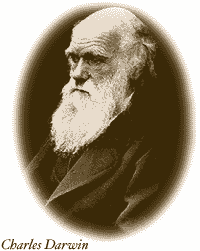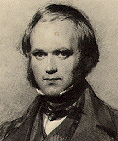|
Charles Darwin: The Father
of Evolution
|
Abstract

In his life, Charles Darwin helped to make significant advances in the
way mankind in general views the world and themselves. Through his studies
aboard Her Majestyís Ship, the Beagle, Darwin made stunning observations,
which led to the paradigm shift referred to today as evolution. His ideas
inspired his predecessors an, when paired with other great minds work,
led to an entirely new understanding of mankind and their place in the
world.
Historical Background
The lifespan of Charles Darwin lasted from 1809 until 1882. Prior to
his contributions to the field of evolutionary science, there was a prevalent
following of Lmarckian evolution. This process theorized that evolution
was the result of an organisms desire to change. Lamarck taught that organisms
could will themselves into physical changes. This was the beginning of
the shift away from the theory of fixity of the species, which was previously
the only conceived view of organism history.
The fixity of the species idea is one greatly affected by religion and
The
Bible. It states that all organisms have been in an unchanging state
since the great flood and that everything was molded in God's will. Because
God Is perfect, therefore, all of nature would remain stagnant and permanent,
lacking a need to adapt or conform because it was perfect in its conception.
By the end of the eighteenth century, this fixity of the species paradigm
began to crumble when the fossilized remains of organisms no longer present
in the living spectrum were uncovered. These discoveries poked holes in
the fabric of the theory of constant stability and made way for thinkers
like Darwin to change the world and it's views.
Research
Report
Charles Darwin was born into the upper middle class on February 12,
1809 to a country physician by the name of Robert Waring Darwin. He attended
the best schools in his youth, including the esteemed Edinburgh University
in Scotland where he was expected to follow in his father and grandfather's
shoes. Even with the best schooling around, Darwin was still a lackadaisical
student at best, who was apathetic towards studies and disliked the time
he spent in school. He did, however, discover a love of history and nature
through his contact with his fellow classmates.

After his schooling did not take and he had given up the idea of following
in his paternal line of doctors, Darwin Moved to Cambridge in order to
study the Holy Orders. As anticipated, he quickly grew bored of this endeavor
also, giving it up in 1831 when he decided to embark on the HMS Beagle's
geological expedition. His father was not a fan of this five-year venture
and viewed it merely as an attempt to delay settling down and doing something
with his life. He finally conceded, however, giving Darwin permission for
this five-year hiatus that led to the complete reversal of worldviews.
On his geological journey, Darwin made stops all around South America,
including Brazil, Argentina, and the Tierra del Fuego making observations
about local species along the way. He also spent time, on this venture,
in the Galapagos Islands, a completely removed set of islands off the coast
of Ecuador.While there, he was able to fill journals with his observations
of the changes in various species, most famously the finches, which matured
with a complete lack of human involvement. In 1836, Darwin returned to
England armed with his observations and never left there again. In 1839,
Darwin fell in love with and married Emma Wedgwood, of the famous pottery
family, and took up residence at an estate called Downhouse, just outside
of London, where the two spent the remainder of their lives together.
While living at Downhouse, Darwin began to compile his observations
with no real urgency. By 1842, he had created a 35-page summary of his
ideas on natural selection. Around the same time, Alfred Wallace sent him
a transcript that he had been working on. The scenario presented was parallel
to that of Darwinís, which incited motivation to expand on his ideas and
to be the first of the two to publish. At the ripe age of 51, in 1859,
Darwinís Origin of Species was finally completed and published, becoming
one of the most significant texts in history. Although it was a scientific
text, it gained massive notary because it was not cluttered with page upon
page of technical jargon. Written in plain English, Darwinís "masterpiece"
was accessible and understandable to the average person, which is one reason
why his ideas were so widely dispersed.
This work reversed the thinking of many areas previously untouched because
of the general acceptance of the fixity of the species theory of God-ordained
perfection. Darwin argued that the globe has and will continue to undergo
systematic transformations and that biological change is similarly connected.
He felt that there was an unlimited natural supply of hereditary possibility,
this supply was only expanded through the phenomenon of mutations. He was
among the first to imply that there was abundant internal variability with
only portions that were externally manifested. He also argued that in the
unremitting struggle to exist, only the fittest individuals would prosper.
Those which are best suited for a given environment will live the longest,
reproduce more, and pass on more of their genetic material than the weaker
members of a species.
Charles Darwin lived out the remainder of his life at Downhouse. Altogether
he and his wife had 10 children, however only 7 of them lived until the
point of maturity. When he died, Darwin was not buried on the property
at Down, instead, he was buried at Westminster Abbey, near Sir Isaac Newton,
Sir Charles Lyell, Michael Faraday, and William Herschel. This was an ironic
end to the father of evolutions life. After theorizing in ways so controversial
within the Church, he was buried in one of it's holiest, most scared locations.
Darwin's pall bearers included the President of the Royal Society, the
American Minister to the British Isles (Robert Lowell), the churchman Cannon
Farrar, an earl, two dukes,as well as three of his contemporary British
biologists who were among his closest scientific friends: Thomas Huxley,
Sir Joseph Hooker,. and Alfred Russel Wallace.
Historical Significance
The major defaults of Darwinís theory are concerned with information
he was lacking at the time. In the time of Darwin, innovation in genetics
by people such as Mendel had not yet occurred. This means that he had no
knowledge on theories of inheritance, DNA, or other genetic principles.
He could describe his ideas of mutations, but had no more verification
than previous scientists. The other major weakness in his theory was the
complete omission of the human evolutionary structure. It was assumed that
humans fell victim to the same evolutionary proceedings as every other
organism, however, this thought was not popular among many that believed
man to be above all else.
Darwinís ideas and discoveries opened the door for a new period of scientific
thought. Although many of his ideas were a bit radical, extreme, and unfounded,
with further search into the field of evolution it is seen that his work
provided a stable jumping off point for all evolutionary work to follow.
Work being done at the present Darwin Center on the Galapagos Islands is
attempting to keep intact this last great microcosm of evolution in itís
most pure and simple form, without human interference.
Darwin also had an enormous impact in a forum that he never could have
anticipated, in the social realm. Darwinís idea were mutated and distorted
into a concept of "social Darwinism" which was used by many to justify
imperialism and foster the concept of the "White Manís Burden." Concepts
such as this were never Darwinís original intention, but as with all things
in life, something in itís most pure and simple form can evolve into an
unrecognizable entity.
References
Campbell, Bernard. Human Evolution, Fourth Edition. New York:
Aldine de Gruyter, 1998 (pages 1-50).
Darwin, Charles. The Origin of Species. New York: A Mentor Book,
1958 (pages 31-459).
McKay/Hill/Buckler. A History of Western Society:
Sixth Edition. Boston: Houghton Mifflin Company, 1999 (pages 814-815).
Huxley, Julian. The Living Thoughts of Darwin. London,
1958.
Moorehead, Alan. Darwin and the Beagle. New York: Harper
& Row, Publishers, 1969 ( pages 19-270).
Web Resources
http://honors.ccsu.ctstateu.edu/Honors/EText/Darwin/DarwinTimeLine.html
- A comprehensive timeline of Charles Darwin's life.
http://userwww.sfsu.edu/~rsauzier/Darwin.html
- Biographical account of Darwin's life.
http://www.charlesdarwinresearch.org/
- A good site outlining current conservation attempts on the Galapagos
Islands.
http://www.sc.edu/library/spcoll/nathist/darwin/darwin.html
- Internet exhibit on Charles Darwin.
http://www.csuchico.edu/~curban/Darwin/DarwinSem-S95.html
- A lengthy paper on Darwin's research; by Dr. Charles Urbanowicz
http://emporium.turnpike.net/~mscott/darwin.htm
- a brief overview of the life of Charles Darwin
http://geoclio.st.usm.edu/darwin.html
- offers several of his geological diagrams
http://web.clas.ufl.edu/users/rhatch/05-DARWIN-PAGE.html
- a chronology of the times of Darwin
http://camel2.conncoll.edu/academics/departments/philosophy/courses/beagle/index/
- illustration and summary of Darwin's works
http://www.humanists.org/dday.htm
- brief discussion of Darwin Day and typical activities to celebrate it

